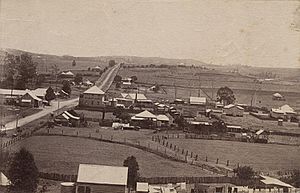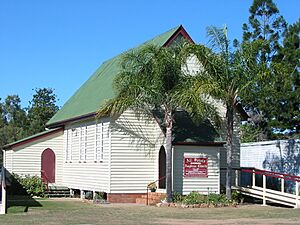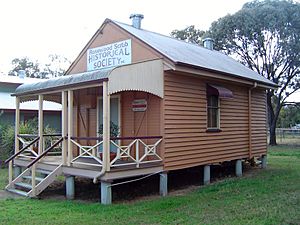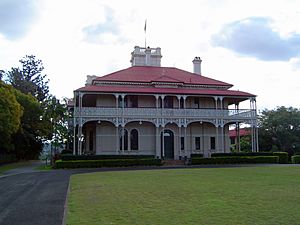Marburg, Queensland facts for kids
Quick facts for kids MarburgQueensland |
|||||||||||||||
|---|---|---|---|---|---|---|---|---|---|---|---|---|---|---|---|

Intersection of Edmond Street and Queen Street, Marburg, 2011
|
|||||||||||||||
| Population | 1,013 (2021 census) | ||||||||||||||
| • Density | 55.97/km2 (145.0/sq mi) | ||||||||||||||
| Postcode(s) | 4346 | ||||||||||||||
| Area | 18.1 km2 (7.0 sq mi) | ||||||||||||||
| Time zone | AEST (UTC+10:00) | ||||||||||||||
| Location |
|
||||||||||||||
| LGA(s) |
|
||||||||||||||
| State electorate(s) |
|
||||||||||||||
| Federal Division(s) | Blair | ||||||||||||||
|
|||||||||||||||
Marburg is a rural town in Queensland, Australia. It is part of the City of Ipswich and also stretches into the Somerset Region. In 2021, about 1,013 people lived in Marburg.
Contents
Marburg's Location and Landscape
Marburg is located about 50 kilometers (31 miles) west-south-west of Brisbane, the capital city of Queensland. The town sits on land that is between 80 and 120 meters (260 to 390 feet) above sea level.
A small stream called Black Snake Creek flows through Marburg. It gets its name from the Red-bellied Black Snake, which is a type of snake found in Australia. The Rosewood–Marburg Road leads into the town from the south.
Marburg's Past: A Glimpse into History
Early Settlers and the Town's Name
Around the 1860s, German settlers arrived in this area. This land originally belonged to the Indigenous Jagera people. The district was first called Sally Owens Plains.
The town's name, Marburg, comes from a town in Hesse, Germany. Legend says that when people asked the settlers where they lived, they would often say 'ober dar' (meaning 'over there'). Eventually, they named their new home after the German town of Marburg, which was well-known at the time.
Growing Industries and Town Life
Marburg grew thanks to industries like timber, sugar cane, and dairy farming. In 1884, about 46 acres of land were divided into 200 blocks and sold. Advertisements mentioned the cleared Rosewood Scrub, nearby towns, and future rail and telegraph services.
By 1900, Marburg was a busy place. It had a courthouse, a police station, a post office, two hotels, five churches, a State school, and a School of Arts. There were also several stores, a blacksmith, a butter factory, a sugar factory, and even a rum distillery. At that time, nearly 80% of the people in Marburg were from Germany or had German family.
Marburg State School's Journey
Frederick State School first opened its doors on March 18, 1879. Its name was changed to Marburg State School in 1888. For a while, from 1920 to 1934, it also had a "rural school" section. This part taught practical skills useful for farming. In 1977, a pre-school center was added for younger children.
Post Office and Church History
The Marburg Post Office opened on October 1, 1879. It was briefly renamed Townshend in 1917 during World War I, but changed back to Marburg in 1919.
All Saints' Anglican Church was officially opened on July 4, 1891. It was built on land given by Thomas Lorimer Smith, who owned the large house called Woodlands. The church was designed by architect George Brockwell Gill.
The church was originally located outside the main town. In the 1970s, plans to widen the Warrego Highway meant part of the church's land was needed. So, the church building was moved to Queen Street in 1977, next to its church hall. The cemetery, however, stayed at the original site.
Railway and Road Changes
In 1912, a railway line connecting Rosewood to Marburg was opened. However, trains soon faced competition from cars and trucks on the roads. The railway line eventually closed in 1965. There were two train stations in the area:
- Marburg railway station (27°33′56″S 152°35′40″E / 27.5656°S 152.5944°E)
- Malabar railway station (27°35′02″S 152°35′24″E / 27.5839°S 152.5900°E)
The Name Change Debate
During World War I, some politicians had anti-German feelings. Because of this, Marburg's name was changed to Townshend. However, the local people did not like this change. A local doctor, Dr. Sirois, worked hard to get the name Marburg brought back after the war in 1920. This caused some arguments, but the name Marburg won out.
In the 1960s, the Warrego Highway was built. This new highway bypassed Marburg, meaning most traffic from Brisbane to Toowoomba no longer passed through the town center. As a result, Marburg became less busy and its population decreased for a time.
Marburg's Population
The number of people living in Marburg has changed over the years:
- In 2011, Marburg had a population of 567 people.
- In 2016, the population grew to 873 people.
- In 2021, the population reached 1,013 people.
Important Heritage Sites
Marburg has several places that are listed for their historical importance:
- Edmond Street: Marburg Hotel
- 71 Edmond Street: Marburg Community Centre and First World War Memorial
- 73 Edmond Street: Rosewood Scrub Historical Society Building
- Louisa Street: Marburg State School
- Seminary Road: Woodlands
Education in Marburg
Marburg State School is a government primary school for students from Prep (the first year of school) to Year 6. It is located on Louisa Street (27°33′45″S 152°35′38″E / 27.5624°S 152.5939°E). In 2017, the school had 52 students.
Community Life and Services
Marburg has many active community groups. These include the Marburg and District Resident's Association and the Rosewood Scrub Historical Society. There is also the Marburg Harness Racing Club and the Marburg Show Society.
The town is home to the Marburg Fire and Rescue Station and the Marburg Rural Fire Brigade. It also has a local branch of the State Emergency Services (SES).
Weekly Sunday church services are held at All Saints' Anglican Church at 111 Queen Street (27°33′56″S 152°35′48″E / 27.5656°S 152.5966°E).
A "street library" was set up in the town park by the Marburg Residents Association. It even has a small reading room shaped like a traditional Australian outhouse!
Local Attractions
'Woodlands' is considered Marburg's most impressive building. It is a great example of a large house owned by a plantation owner from the 1800s. It shows the history of farming industries in Queensland. Thomas Lorrimar Smith, who owned a sawmill, sugar mill, and distillery, built it between 1888 and 1891. Today, 'Woodlands' is used for events like weddings, business meetings, and conferences.
Events and Activities
The Marburg Black Snake Creek Festival is a fun event held every October. It features musicians and other attractions for everyone to enjoy.
The 'Band in the Park' is a musical event organized by the Marburg and District Resident's Association. It takes place on the first Friday of every month at 6:30 PM.
Marburg is also famous for its 'Marburg Dances'. These dances happen every Saturday night in the hall at the showgrounds.
Harness racing is a popular sport in Marburg. Races are held regularly at the Marburg race course, also located at the showgrounds.







